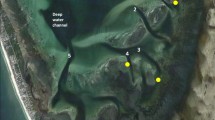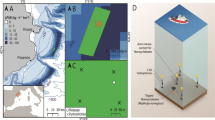Abstract
The horizontal and vertical movements of bigeye (Thunnus obesus Lowe, 1839) and skipjack (Katsuwonus pelamis Linnaeus, 1758) tunas within large multi-species aggregations associated with moored buoys or a drifting vessel were investigated, using ultrasonic telemetry and archival tags, along with sonar imaging, in the equatorial eastern Pacific Ocean (at 2°S–95°W and 2°N–95°W). Four sets of observations, each consisting of the concurrent monitoring of pairs of skipjack and/or bigeye with implanted acoustic or archival tags, were conducted in May 2002 and 2003. Ultrasonic telemetry data were not collected until 24 h or more after the fish were tagged and released, to avoid any abnormal behavior as a consequence of tagging. The pairs of acoustically tagged bigeye and skipjack, and also the entire aggregations, were primarily upcurrent of the moored buoy and downcurrent of the drifting vessel during the day. At night the aggregations were observed to be more diffuse, and the fish were feeding on organisms of the deep scattering layer. The aggregations returned to positions upcurrent of the buoy or downcurrent of the drifting vessel at dawn, commonly breezing at the surface within cohesive monospecific schools. The bigeye and skipjack had concurrent changes in depth records, occupying significantly greater mean depths at night than during the day, in most cases. When associated with a moored buoy, bigeye depth distributions were deeper during the day and night than those of skipjack, but bigeye depth distributions were shallower during the day and night than those of skipjack when associated with the drifting vessel. Simultaneous depth records of a large and a small bigeye with archival tags associated with a moored buoy also indicated diel changes in depth. The mean depth at night was significantly less than during the day for the larger bigeye, but the mean depth during the day was significantly less than during the night for the smaller bigeye. The mean depths during the day and night were significantly greater for the larger bigeye than the smaller.





Similar content being viewed by others

References
Arnold G, Dewar H (2001) Electronic tags in marine fisheries research: a 30-year perspective. In: Sibert JR, Nielsen JL (eds) Electronic tagging and tracking in marine fisheries. Kluwer, Dordrecht, The Netherlands, pp 7–64
Batalyants KY (1993) On the hypothesis of comfortability stipulation of tuna association with natural and artificial floating objects. ICCAT Coll Doc Sci 40:447–453
Bayliff WH (ed) (2002) Annual report for 2001. Inter-American Tropical Tuna Commission, La Jolla, Calif., USA
Blackburn M (1968) Micronekton of the eastern tropical Pacific Ocean: family composition, distribution, abundance and relations to tuna. Fish Bull (Wash DC) 67:71–115
Block BA, Keen JE, Castillo B, Dewar H, Freund EV, Marccinek DJ, Brill RW, Farwell C (1997) Environmental preferences of yellowfin tuna (Thunnus albacares) at the northern extent of its range. Mar Biol 130:119–132
Boustany AM, Marcinek DJ, Keen J, Dewar H, Block BB (2001) Movements and temperature preferences of Atlantic bluefin tuna (Thunnus thynnus) off North Carolina: a comparison of acoustic, archival and pop-up satellite tags. In: Sibert JR, Nielsen JL (eds) Electronic tagging and tracking in marine fisheries. Kluwer, Dordrecht, The Netherlands, pp 89–108
Brill RW, Block BA, Boggs CH, Bigelow KA, Freund EV, Marcinek DJ (1999) Horizontal movements and depth distribution of large adult yellowfin tuna (Thunnus albacares) near the Hawaiian Islands, recorded using ultrasonic telemetry: implications for the physiological ecology of pelagic fishes. Mar Biol 133:395–408
Carey FG (1983) Experiments with free-swimming fish. In: Brewer PG (ed) Oceanography—the present and future. Springer, New York Berlin Heidelberg, pp 57–68
Castro JJ, Santiago JA, Santana-Ortega AT (2002) A general theory on fish aggregation to floating objects: an alternative to the meeting point hypothesis. Rev Fish Biol Fish 11:255–277
Cayré P (1991) Behavior of yellowfin tuna (Thunnus albacares) and skipjack tuna (Katsuwonus pelamis) around fish aggregating devices (FADs) in the Comoros Islands as determined by ultrasonic tagging. Aquat Living Resour 4:1–12
Cayré P, Chabanne J (1986) Marquage acoustique et comportement de thons tropicaux (albacore: Thunnus albacares, et listao: Katsuwonus pelamis) au voisinage d’un dispositif concentrateur de poisons. Oceanogr Trop 21:167–183
Clark CW, Mangel M (1979) Aggregation and fishery dynamics: a theoretical study of schooling and the purse seine tuna fisheries. Fish Bull (Wash DC) 77:317–329
Dagorn L, Josse E, Bach P (2001) Yellowfin tuna (Thunnus albacares) associated with tracking vessels during ultrasonic telemetry experiments: contribution to the tuna/floating objects issue. Fish Bull (Wash DC) 99:40–48
Davis TLO, Stanley CA (2001) Vertical and horizontal movements of southern bluefin tuna (Thunnus maccoyii) in the Great Australian Bight observed with ultrasonic telemetry. Fish Bull (Wash DC) 100:448–465
Dizon AE, Brill RW, Yuen HSH (1978) Correlations between environment, physiology, and activity and the effects on thermoregulation in skipjack tuna. In: Sharp GD, Dizon A (eds) The physiological ecology of tunas. Academic, New York, pp 233–259
Freon P, Dagorn L (2000) Review of fish associative behavior: toward a generalization of the meeting point hypothesis. Rev Fish Biol Fish 10:183–207
Gunn J, Block B (2001) Advances in acoustic, archival, and satellite tagging of tunas. In: Block BA, Stevens ED (eds) Tunas: ecological physiology and evolution. Academic, San Diego, pp 167–224
Holland KN, Brill RW, Chang RKC (1990) Horizontal and vertical movements of yellowfin and bigeye tuna associated with fish aggregating devices. Fish Bull (Wash DC) 88:493–507
Hunter JR, Mitchell CT (1966) Association of fishes with flotsam in the offshore waters of central America. Fish Bull (Wash DC) 66:13–29
Josse E, Bach P, Dagorn L (1998) Simultaneous observations of tuna movements and their prey by sonic tracking and acoustic surveys. Hydrobiologia 371/372:61–69
Klimley AP, Holloway CF (1999) School fidelity and homing synchronicity of yellowfin tuna, Thunnus albacares. Mar Biol 133:307–317
Klimley AP, Jørgensen S, Muhlia-Melo A, Beavers S (2003) The occurrence of yellowfin tuna (Thunnus albacares) at Espiritu Santo seamount in the Gulf of California. Fish Bull (Wash DC) 101:684–692
Kuznetsov IL, Stefanov SR, Savagov VI (1982) A migrating sound scattering layer in the equatorial Pacific Ocean. Oceanology 22:702–703
Lauck T (1996) Uncertainty in fisheries management. In: Gordon DV, Munro GR (eds) Fisheries and uncertainty: a precautionary approach to resource management. University of Calgary Press, Calgary, pp 91–105
Lennert-Cody CE, Hall MA (2000) The development of the purse seine fishery on drifting fish aggregating devices in the eastern Pacific Ocean: 1992–1998. In: Le Gall JY, Cayré P, Taquet M (eds) Pêche Thonière et Dispositifs de Concentration de Poissons, Colloque Caraïbe-Martinique, vol 28. Inst Fran Recherche Exploitation Mer (IFREMER), Plouzane, pp 78–107
Maunder MN, Harley SJ (2002) Status of bigeye tuna in the eastern Pacific Ocean in 2001 and outlook for 2002. Stock Assessment Report 3, Inter-American Tropical Tuna Commission, La Jolla, Calif., USA, pp 201–311
Menard F, Stequert B, Rubin A, Herrera M, Marchal E (2000) Food consumption of tuna in the equatorial Atlantic Ocean: FAD-associated versus unassociated schools. Aquat Living Res 13:233–240
Ohta I, Shinichiro K, Kiyoaki K (2001) Aggregating behavior of yellowfin and bigeye tuna tagged with coded ultrasonic transmitters around FADs in Okinawa, Japan. In: Sibert JR, Nielsen JL (eds) Electronic tagging and tracking in marine fisheries. Kluwer, Dordrecht, the Netherlands, pp 131–145
Olson RJ, Boggs CH (1986) Apex predation by yellowfin tuna (Thunnus albacares): independent estimates from gastric evacuation and stomach contents, bioenergetics, and cesium concentrations. Can J Fish Aquat Sci 43:1760–1775
Schaefer KM, Fuller DW (2002) Movements, behavior, and habitat selection of bigeye tuna (Thunnus obesus) in the eastern equatorial Pacific, ascertained through archival tags. Fish Bull (Wash DC) 100:765–788
Scott JM (1969) Tuna schooling terminology. Calif Fish Game 55:136–140
Tsukagoe T (1981) Fishing skipjack tuna schools associated with shoals and drifting objects. Suisan Sekai 30:78–81. NOAA NMFS Translation no. 83 by Tamio Otsu
Tont SA (1976) Deep scattering layers: patterns in the Pacific. Calif Coop Ocean Fish Investig Rep 18:112–117
Yuen HSH (1970) Behavior of skipjack tuna, Katsuwonus pelamis, as determined by tracking with ultrasonic devices. J Fish Res Board Can 27:2071–2079
Acknowledgements
We greatly appreciate the assistance by Captain B. Blocker and the crew aboard “Her Grace” while conducting these field studies. We thank B. Bayliff, S. Harley, and two anonymous reviewers for their comments on drafts of the manuscript. This research was part of the Inter-American Tropical Tuna Commission’s bigeye tuna tagging program, made possible through financial support provided by the Japan Fisheries Agency. These studies were conducted on the high-seas, outside the 200 nm EEZ of any country; regardless, the experimental procedures complied with the current laws of the United States.
Author information
Authors and Affiliations
Corresponding author
Additional information
Communicated by J.P. Grassle, New Brunswick
Electronic Supplementary Material
Rights and permissions
About this article
Cite this article
Schaefer, K.M., Fuller, D.W. Behavior of bigeye (Thunnus obesus) and skipjack (Katsuwonus pelamis) tunas within aggregations associated with floating objects in the equatorial eastern Pacific. Marine Biology 146, 781–792 (2005). https://doi.org/10.1007/s00227-004-1480-x
Received:
Accepted:
Published:
Issue Date:
DOI: https://doi.org/10.1007/s00227-004-1480-x



